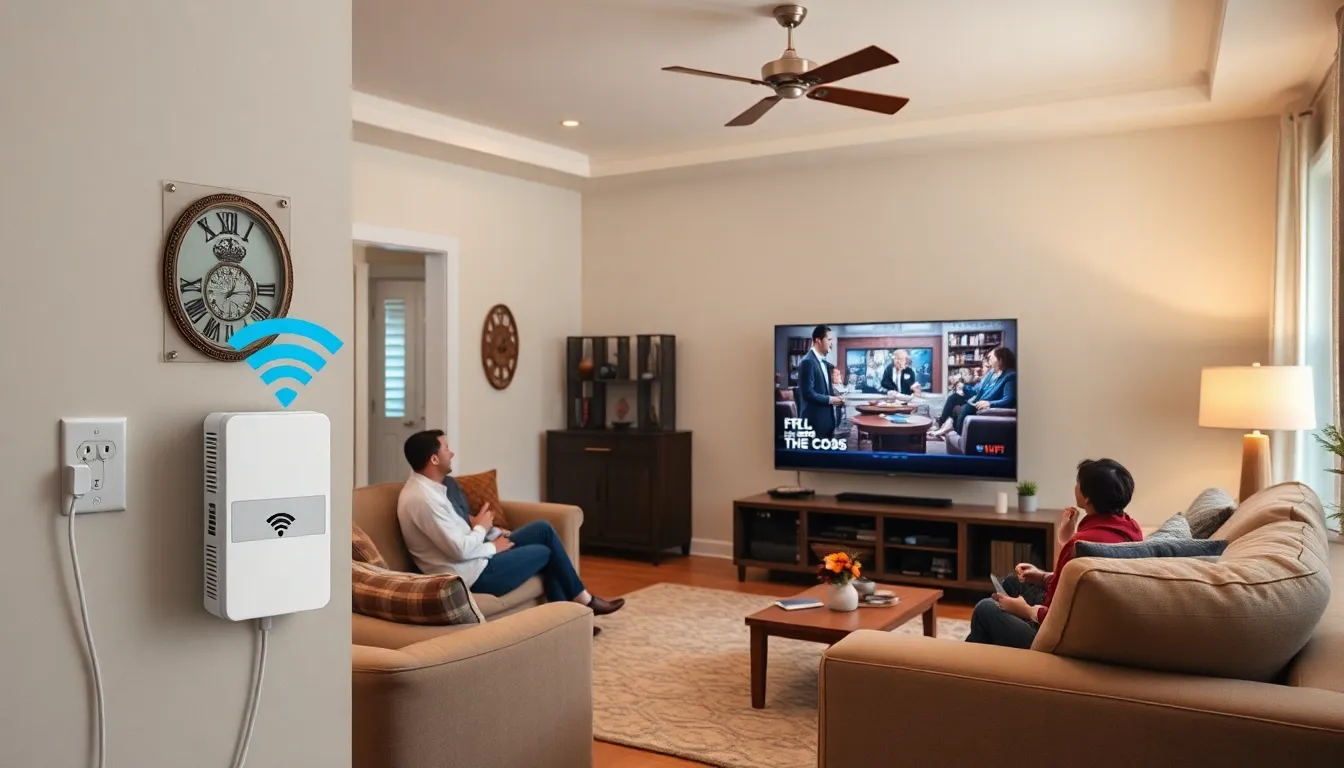In a world where buffering videos can feel like an eternity, having a strong WiFi signal isn’t just a luxury—it’s a necessity. Picture this: you’re in the middle of an epic online gaming session, and suddenly the dreaded loading symbol appears. Frustrating, right? A weak signal can turn even the simplest tasks into a test of patience.
Table of Contents
ToggleWhat Is WiFi Signal Boost?
WiFi signal boost refers to methods or devices aimed at enhancing the strength and coverage of a wireless internet connection. The main goal is to eliminate dead zones, ensuring a stable internet experience throughout a home or office space. Signal boosters increase the reach of a WiFi network by amplifying the existing signal, which can be critical for activities like streaming video or online gaming.
Various types of WiFi signal boosters exist on the market. Range extenders connect to the router and relay signals to further areas. Mesh systems utilize multiple nodes to create a blanket of coverage across larger spaces. Powerline adapters also act as signal boosters by using electrical wiring to transmit data, effectively bypassing physical barriers.
Signal boosting devices connect easily to most routers. Installation typically involves minimal setup with user-friendly interfaces. Wireless network users benefit from boosted signals, experiencing increased speeds and reduced latency. Improvements often manifest in applications that demand high bandwidth, such as video conferencing or virtual reality gaming.
Understanding the importance of WiFi signal boost aids in selecting the right device. Specific needs might differ based on the layout of a building or the number of devices connecting to the network. Evaluating the size of coverage areas and the types of activities performed online helps tailor solutions for optimal performance.
Effective WiFi signal boosts can significantly enhance the digital experience. With the proper implementation, users enjoy seamless connectivity in any corner of their environment.
Benefits of WiFi Signal Boost

WiFi signal boosting significantly enhances the overall network experience. It addresses common connectivity issues, providing users with a reliable internet connection.
Improved Coverage
Enhanced coverage minimizes dead zones in homes and workplaces. These devices, like range extenders and mesh systems, increase signal strength in difficult-to-reach areas. Users experience uninterrupted connectivity throughout their space, whether in a basement or backyard. Boosters can extend coverage up to 2,500 square feet or more, depending on the device. Families can stream movies in one room while others use the internet in another, promoting seamless online engagement.
Enhanced Speed
WiFi signal boosters improve internet speed, leading to faster downloads and smoother streaming. When the connection strengthens, latency decreases. Users can enjoy high-definition videos and online gaming without disruption. Devices often support speeds exceeding 300 Mbps, ensuring that multiple users can connect without compromising performance. Gamers particularly benefit, as improved speeds enhance real-time experiences during competitive play.
Methods to Achieve WiFi Signal Boost
Several effective methods enhance WiFi signal strength and coverage. Understanding these options empowers users to optimize their internet experience.
WiFi Extenders
WiFi extenders, also known as repeaters, amplify the existing wireless signal. These devices connect to the router and relay signals to areas with weak connectivity. Installation often features a simple setup process, making them accessible for most users. Depending on the specific model, some extenders can cover distances up to 3,000 square feet. They enhance connectivity in larger homes or offices, eliminating dead zones effectively.
Mesh WiFi Systems
Mesh WiFi systems comprise multiple interconnected nodes working together to create a seamless network. Each node broadcasts and strengthens the WiFi signal, ensuring consistent coverage throughout larger spaces. Unlike traditional routers, these systems adapt to user needs, providing reliability when multiple devices connect. Often, mesh systems can cover up to 6,000 square feet, providing extensive coverage without compromising speed. As a result, families and remote workers benefit from stable connections across various locations in their home.
Firmware Updates
WiFi devices require regular firmware updates to maintain optimal performance. Manufacturers frequently release updates that enhance security and stability while fixing existing bugs. Regular updates improve device efficiency, potentially leading to increased speeds and better reliability. Users should check their device settings periodically, ensuring they install the latest firmware versions. It’s important to realize that a device lacking current updates might underperform significantly compared to its potential capabilities.
Factors Affecting WiFi Signal Strength
Several factors impact the strength of a WiFi signal. Understanding these elements helps users optimize their connectivity and enhance overall performance.
Physical Obstructions
Physical obstructions significantly reduce WiFi signal strength. Thick walls, floors, and large furniture can block signals from reaching devices effectively. Metal objects, such as filing cabinets and appliances, also pose obstacles. Placing routers higher and in open spaces often improves signal distribution. Line of sight between the router and devices leads to stronger connections. Users should strategically position routers to minimize obstruction impacts.
Interference from Other Devices
Interference from other devices hampers WiFi signal strength. Common household items, like microwaves and cordless phones, operate on similar frequencies as WiFi, causing disruptions. Bluetooth devices can also interfere with WiFi signals in some cases. Maintaining distance between the router and such devices helps mitigate interference. Users often find that switching WiFi channels can enhance performance, allowing for clearer signal paths. Understanding these interferences can guide users in creating an optimal WiFi environment.
A strong WiFi signal is crucial for a seamless online experience. By utilizing WiFi signal boosters like range extenders and mesh systems, users can significantly enhance their internet connectivity. These devices not only eliminate dead zones but also improve overall speed and performance, making them ideal for activities like gaming and streaming.
Understanding the factors that affect WiFi strength allows users to optimize their setups for maximum efficiency. Regular maintenance and strategic placement of equipment can further enhance performance. Investing in the right signal boosting solutions ultimately leads to a more reliable and enjoyable internet experience for everyone in the household or workplace.




